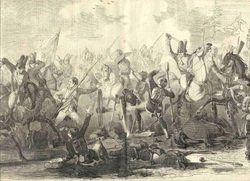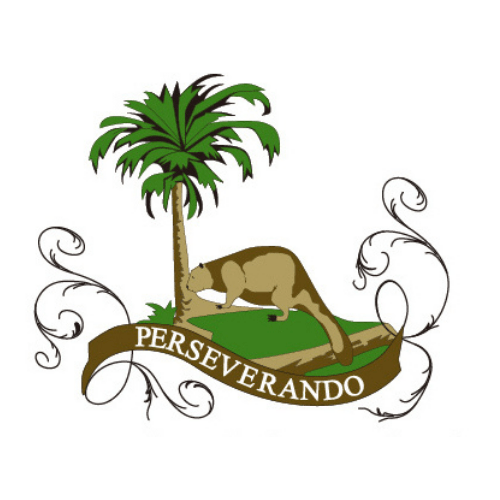The
Battle

The Story of the Massacre
On May 27, Lt. Col. Tarleton set out from Nelson's Ferry with 270 men in pursuit of South Carolina Governor John Rutledge, who was said to be traveling with Col. Buford. On May 29, Lt. Col. Tarleton caught up with Col. Buford and his men. Buford refused to surrender and was quickly defeated by Tarleton's cavalry. The aftermath of the battle became controversial and settled Tarleton's reputation in the South for no mercy.
On May 6, 1780 at Lenud's Ferry, Col. Abraham Buford and 350 Virginia Continentals had watched helplessly from the far bank of the Santee River when Lt. Col. Banastre Tarleton had dispersed a force of Continentals including Lt. Col. William Washington. They had been on their way to Charleston as reinforcements.
On May 12, however, the Siege of Charleston ended when Maj. Gen. Benjamin Lincoln surrendered to Gen. Henry Clinton. When word of the surrender reached Col. Buford, he held his position and awaited new orders. Brig. Gen. Isaac Huger, who had been surprised by Lt. Col. Tarleton at the Battle of Moncks Corner on April 14, ordered Col. Buford to retreat to Hillsborough, North Carolina.
On May 18, 1780, Lt. Gen. Charles Cornwallis commanding 2,500 men marched out of Charleston with orders from Gen. Clinton to subdue the backcountry and establish outposts. He made his way to Lenud's Ferry and crossed the Santee River and headed for Camden. Along the way, Cornwallis learned that South Carolina Governor John Rutledge had used the same route under the escort of Col. Buford. Rutledge had managed to flee Charleston during the early stages of the siege.
However, Col. Buford was ten days ahead, so Gen. Cornwallis' only chance was to send Lt. Col. Tarleton after Col. Buford. On May 27, Tarleton set out from Nelson's Ferry with 270 men. His command force included forty British regulars of the 17th Dragoons, 130 of his British Legion cavalry, 100 of his British Legion infantry, mounted on this occasion, and one three-pound artillery piece.
Since Col. Buford had such a large lead on them, Gen. Cornwallis had given Lt. Col. Tarleton discretion to continue the pursuit, turn back or attack Col. Buford if he caught up with him. Tarleton was at Camden the next day. At 2:00 a.m. on May 29, he set out again and reached Rugeley's Mill by mid-morning. There, he learned that Governor Rutledge had been there the night before and Col. Buford was now only twenty miles ahead.
Lt. Col. Tarleton sent a messenger ahead requesting that Col. Abraham Buford surrender. In the message, Tarleton exaggerated his forces in hopes of scaring Buford into surrender, or at least delaying him. After delaying the messenger, while his infantry reached a favorable position, Buford declined in a one sentence reply: "Sir, I reject your proposals, and shall defend myself to the last extremity."
Around three o'clock in the afternoon on May 29, 1780, Lt. Col. Tarleton caught up with Col. Buford near the Waxhaw’s district on the border of North and South Carolina. Tarleton's advance guard slashed through Buford's rear guard. Buford now formed his men up in a single line, while it is unknown what he did with Lt. Col. William Washington's dragoons. Meanwhile, Tarleton did not wait for his stragglers to catch up, but continued to press the attack.
Lt. Col. Tarleton assigned fifty cavalry and fifty infantry to harass Col. Buford's left flank. Another forty cavalry were to charge at the center of Buford's line, while Tarleton would take another thirty cavalry to Buford's right flank and reserves. He formed up his troops on a low hill opposite the American line. At 300 yards, his cavalry began their charge.
When Lt. Col. Tarleton's cavalry was fifty yards from Col. Buford's line, the Americans presented their muskets, but they were ordered to hold their fire until the British were closer. Finally, at ten yards, Buford's men opened up, but that was too close for cavalry. Tarleton's horse was killed under him, but the American line was broken and in some cases, ridden down. The rout began and controversy soon followed.
The details of what happened following the battle are still under controversy. Lt. Col. Banastre Tarleton claimed that his horse was shot out from under him and he was pinned. His men, thinking that their commander had been shot and killed under a flag of truce, angrily attacked again. They slashed at anyone and everyone, including men who were kneeling with their hands up in surrender.
Patriots claimed that Lt. Col. Tarleton himself ordered the renewed attack because he didn't want to bother with taking prisoners. Based on his aggressive style and zeal for brutal charges in other engagements, the Patriot claims are usually given more credence. Although the first complete statement claiming a massacre did not appear until 1821 in a letter from Dr. Robert Brownfield to William Dobein James.
Either way, the slaughter lasted fifteen minutes. The result was 113 Continentals killed and 203 captured with 150 of those wounded. Col. Buford himself managed to escape. There were only five killed and twelve wounded on the British side. The controversy continues to this day, but it took only days for Lt. Col. Tarleton to be branded with the reputation for which he is remembered even now.
Lt. Col. Tarleton became known as 'Bloody Ban' or 'Ban the Butcher.' For the remainder of the war in the South, 'Tarleton's Quarter' meant no quarter and Buford's Massacre became a rallying cry for Patriots. It was on the lips of the Over Mountain Men at the Battle of Kings Mountain in October 1780 during their defeat of Maj. Patrick Ferguson. There was no indication that Tarleton minded the nickname. Meanwhile, Lt. Gen. Charles Cornwallis occasionally reminded Tarleton to look after the behavior of his men.
Lewis, J. D. (2009). Carolana. Retrieved June 2, 2013, from http://www.carolana.com/SC/Revolution/home.html


